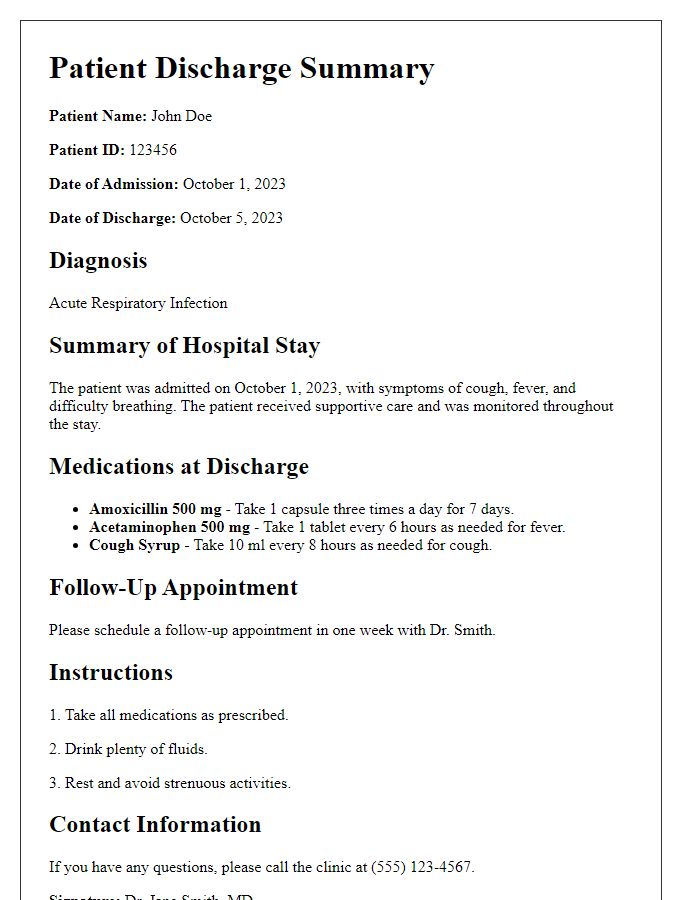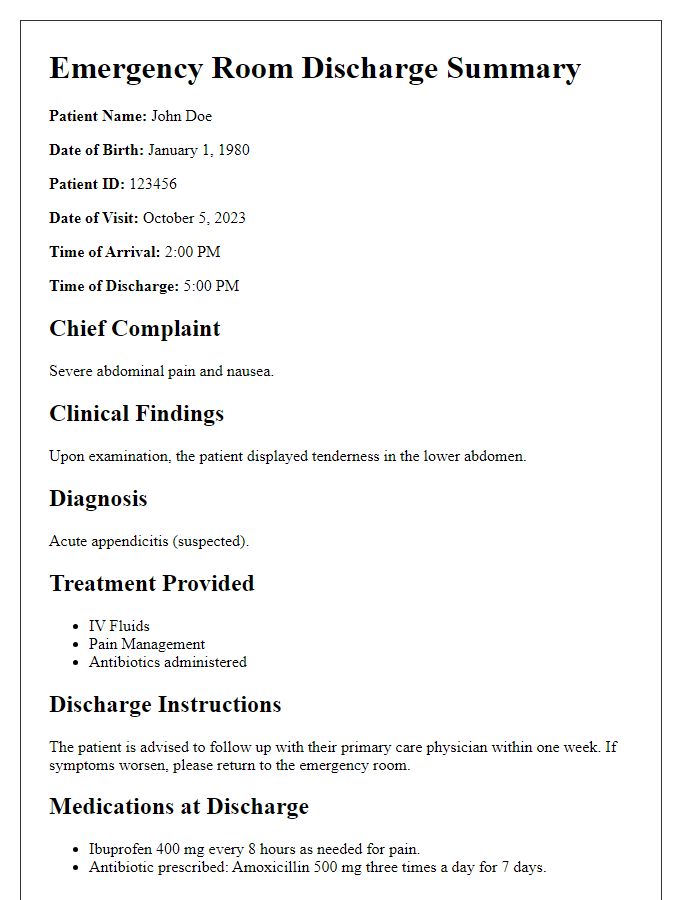When it comes to ensuring a smooth transition from hospital to home, a patient discharge summary plays a crucial role. This important document not only outlines the patient's treatment and progress but also provides essential instructions for further care. By communicating effectively with the patient and their support system, we can promote recovery and prevent unnecessary readmissions. Curious about how to craft the perfect discharge summary? Let's dive deeper into this topic!

Patient Identification Details
Patient identification details ensure accurate records and aid in the continuity of care. This includes full name, date of birth, and unique medical record number, which is crucial for tracking treatment history. Additionally, contact information such as address and phone number facilitates communication regarding follow-up appointments. Insurance details, including provider name and policy number, help streamline billing processes. Primary care physician's name, along with specialty, provides essential context for ongoing care needs. Finally, inclusion of emergency contact's name and relationship ensures support is readily accessible post-discharge.
Hospitalization Summary
During the hospitalization at General Hospital (Hospital ID: 123456) from October 1, 2023, to October 15, 2023, patient Jane Doe (Patient ID: 78910) underwent treatment for pneumonia (ICD-10 Code: J18.9), characterized by persistent cough, fever, and shortness of breath. Initial symptoms presented on September 28, 2023. Diagnostic chest X-rays revealed bilateral infiltrates, indicating a severe lung infection. Treatment included intravenous antibiotics, specifically Piperacillin-Tazobactam (Zosyn), administered every eight hours for seven days, and supplemental oxygen therapy to maintain oxygen saturation above 92%. Physical therapy sessions were also implemented to improve lung capacity. The patient's vital signs stabilized, and by discharge on October 15, 2023, Jane exhibited no signs of distress, with a normalized respiratory rate and improved overall functional status. Follow-up is scheduled for October 22, 2023, with Dr. Smith at the Pulmonology Clinic.
Diagnosis and Treatment
Patient discharge summaries play a crucial role in communicating essential information regarding a patient's diagnosis and treatment regimen. A comprehensive discharge summary includes the primary diagnosis, such as Diabetes Mellitus Type 2, often noted for elevated blood sugar levels, alongside prevalent comorbidities like Hypertension, which can complicate recovery. Key treatment modalities provided during hospitalization, such as Insulin Therapy initiated on Day 2 of admission and Dosage adjustment based on daily blood glucose monitoring, must be documented. Details about the patient's response to treatments, including significant improvements observed in blood glucose levels, are pertinent. Furthermore, any surgical interventions, such as an Appendectomy performed due to acute appendicitis, should be highlighted alongside postoperative care instructions. It is essential to include follow-up appointments scheduled, medication prescriptions detailing Dosage and Frequency, and any lifestyle modifications advised, such as dietary changes and recommended physical activity, ensuring a clear transition of care post-discharge.
Medications at Discharge
At discharge from the hospital, patients receive a comprehensive list of medications prescribed for ongoing treatment. Common medications include antiplatelet drugs like Aspirin (81 mg daily) that help prevent blood clots, statins such as Atorvastatin (40 mg daily) used for lowering cholesterol levels, and antihypertensives like Lisinopril (10 mg daily) which manage blood pressure effectively. Additionally, pain management may include Acetaminophen (500 mg as needed), and antibiotics like Amoxicillin (500 mg three times a day for seven days) if there was an infection during the hospital stay. It is vital for patients to understand the purpose, dosage instructions, and side effects of each medication to ensure adherence and promote recovery post-discharge. Educational resources and follow-up appointments are typically arranged to support the patient's transition home.
Follow-up Care Instructions
Follow-up care instructions are essential for patient recovery and overall well-being post-discharge. After surgery or treatment, patients should schedule follow-up appointments within one week at their local healthcare provider, ensuring ongoing monitoring of their condition. Medications prescribed, such as pain relievers or antibiotics, must be taken as directed, with any missed doses handled according to specific guidelines. Patients should be aware of potential side effects or warning signs, including severe pain, swelling, or infection symptoms like fever above 100.4 degrees Fahrenheit, necessitating immediate medical attention. Maintaining a balanced diet rich in protein and hydration is vital in aiding recovery, particularly for surgical patients. Activity levels should gradually increase, adhering to recommended restrictions specific to their procedure to prevent complications. Regular communication with caregivers or healthcare providers at clinics or hospitals located throughout the region can facilitate a smooth recovery process.
Letter Template For Patient Discharge Summary Samples
Letter template of patient discharge summary for mental health treatment.

Letter template of patient discharge summary with medication instructions.












Comments